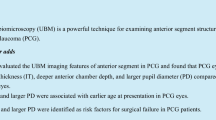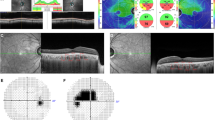Abstract
Purpose
Neurofibromatosis 1 (NF1) is an autosomal dominant, multisystem disorder that also effects the eye. Herein, we aimed to investigate the posterior iris surface and ciliary body morphology of NF1 patients by ultrasonic biomicroscopy (UB).
Materials & Methods
Nine consecutive unrelated subjects with NF1, and as a control group 25 healthy subjects, were included in the study. All patients underwent ophthalmic examination including visual acuity testing, slit-lamp biomicroscopy, tonometry, gonioscopy (Schaffer classification), and dilated ophthalmoscopy, UB.
Results
Mean age was 35.1 ± 16.2 (range, 11–57) and 34.5 ± 15.6 (range, 9–60) for NF1 and control groups respectively (p > 0.05). Lisch nodules were present in 16 of 18 eyes (88.8%) in NF1 group. Fundoscopic examination of the control group and 15 eyes of NF1 (83.3%) patients was normal, whereas hypoplastic and tilted optic nerve were present in three eyes, and temporally-located bone-spicule-like lesions was present in one eye of the NF1 group. UB revealed ciliary body cyst in 77.7% (14/18) of the eyes among NF1 group, and 8% (4/50) among control group (p < 0.05). The mean size of the cysts were 520 ± 191 μ (range, 220–860 μ) and 495 ± 231 μ (range, 300–830 μ) at NF1 and control groups, respectively. Gonioscopic evaluation revealed that 55% of the NF1 patients have an unoccludable anterior chamber angle (Grade 3 or 4), 45% occludable angle (Grade 1 or 2), and 78% irregular pigment patches. However, occludable angle rate was just 4% in the control group, and none of the patients had irregular pigment patches.
Conclusion
The coexistence of ciliary body cysts and NF1, and the effect of these cysts in the eye should be enlightened with further studies.

Similar content being viewed by others
References
Jett K, Friedman JM (2010) Clinical and genetic aspects of neurofibromatosis 1. Genet Med 12:1–11
Williams VC, Lucas J, Babcock MA, Gutmann DH, Korf B, Maria BL (2009) Neurofibromatosis type 1 revisited. Pediatrics 123:124–133
Ferner RE, Huson SM, Thomas N, Moss C, Willshaw H, Evans DG, Upadhyaya M, Towers R, Gleeson M, Steiger C, Kirby A (2007) Guidelines for the diagnosis and management of individuals with neurofibromatosis 1 (NF1). J Med Genet 44:81–88
NIH Consensus Development Conference (1988) Neurofibromatosis. Conference statement. Arch Neurol 45:575–578
Huson S, Jones D, Beck L (1987) Ophthalmic manifestations of neurofibromatosis. Br J Ophthalmol 71:235–238
Kreusel KM (2005) Ophthalmological manifestations in VHL and NF 1: pathological and diagnostic implications. Fam Cancer 4:43–47
Grant WM, Walton DS (1968) Distinctive gonioscopic findings in glaucoma due to neurofibromatosis. Arch Ophthalmol 79:127–134
Morales J, Chaudry IA, Bosley TM (2009) Glaucoma and globe enlargement associated with neurofibromatosis type 1. Ophthalmol 116:1725–1730
Jacquemin C, Bosley TM, Svedberg H (2003) Orbit deformities in craniofacial neurofibromatosis type 1. AJNR Am J Neuroradiol 24:1678–1682
Augsburger JJ, Affel LL, Benarosh DA (1996) Ultrasound biomicroscopy of cystic lesions of the iris and ciliary body. Trans Am Ophthalmol Soc 94:259–271
Tonsgard JH (2006) Clinical manifestations and management of neurofibromatosis type 1. Semin Pediatr Neurol 13:2–7
Boyd KP, Korf BR, Theos A (2009) Neurofibromatosis type 1. J Am Acad Dermatol 61:1–14
Mautner VF, Asuagbor FA, Dombi E, Fünsterer C, Kluwe L, Wenzel R, Widemann BC, Friedman JM (2008) Assessment of benign tumor burden by whole-body MRI in patients with neurofibromatosis 1. Neuro Oncol 10:593–598
Tucker T, Friedman JM, Friedrich RE, Wenzel R, Fünsterer C, Mautner VF (2009) Longitudinal study of neurofibromatosis 1 associated plexiform neurofibromas. J Med Genet 46:81–85
Sippel KC (2001) Ocular findings in neurofibromatosis type 1. Int Ophthalmol Clin 41:25–40
Listernick R, Charrow J, Greenwald MJ, Mets M (1994) Natural history of optic pathway tumors in children with neurofibromatosis type 1: a longitudinal study. J Pediatr 125:63–66
Quaranta L, Semeraro F, Turano R, Gandolfo E (2004) Gonioscopic findings in patients with type 1 neurofibromatosis (Von Recklinghausen disease). J Glaucoma 13:90–95
Kunimatsu S, Araie M, Ohara K, Hamada C (1999) Ultrasound biomicroscopy of ciliary body cysts. Am J Ophthalmol 127:48–55
Cronemberger S, Ferreira DM, Diniz Filho A, Mérula RV, Calixto N (2006) Iridociliary cysts on ultrasound biomicroscopic examinations. Arq Bras Oftalmol 69:471–475
Tanihara H, Akita J, Honjo M, Honda Y (1997) Angle closure caused by multiple, bilateral iridociliary cysts. Acta Ophthalmol Scand 75:216–217
Katsimpris JM, Petropoulos IK, Sunaric-Mégevand G (2007) Ultrasound biomicroscopy evaluation of angle closure in a patient with multiple and bilateral iridociliary cysts. Klin Monatsbl Augenheilkd 224:324–327
Croswston JG, Medeiros FA, Mosaed S, Weinreb RN (2005) Argon laser iridoplasty in the treatment of plateau-like iris configuration as result of numerous ciliary body cysts. Am J Ophthalmol 139:381–383
Financial disclosure
None.
Author information
Authors and Affiliations
Corresponding author
Rights and permissions
About this article
Cite this article
Emre, S., Palamar, M., Ulusoy, M.O. et al. Ciliary body cysts in neurofibromatosis: A new coexistence?. Graefes Arch Clin Exp Ophthalmol 250, 857–861 (2012). https://doi.org/10.1007/s00417-011-1830-6
Received:
Revised:
Accepted:
Published:
Issue Date:
DOI: https://doi.org/10.1007/s00417-011-1830-6




